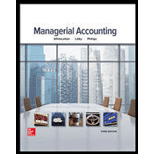
Concept introduction:
Work in Progress inventory means the stock which is still in the process of production.
Finished Goods inventory means those goods on which the work of production is completed, and they are available for sale.
Cost of goods sold means calculate the amount of cost on that inventory which is sold in the market.
Manufacturing
Requirement-1:
To prepare:
Necessary
Concept introduction:
Work in Progress inventory means the stock which is still in the process of production the work on these goods still not completed.
Finished Goods inventory means those goods on which the work of production is completed and they are available for sale.
Cost of goods sold means calculate the amount of cost on that inventory which is sold in the market.
Manufacturing overhead are applied to the process of production on the basis of various methods but the actual manufacturing overhead are different from the applied manufacturing overhead. So the difference between actual and applied is transferred to the cost of goods sold account.
Requirement-2:
To prepare:
Pass journal of transfer of overhead balance to cost of goods sold account.
Want to see the full answer?
Check out a sample textbook solution
Chapter 2 Solutions
MANAGERIAL ACCOUNTING >C<
- PVR Ltd. sold office equipment on March 1, 2015, for a cash price of $520,000. The equipment had a cost of $600,000 and accumulated depreciation of $220,000. Requirements: (a) What is the book value of the equipment on the date sold? (b) What is the gain or loss on the sale of the equipment?arrow_forwardPlease provide the answer to this financial accounting question using the right approach.arrow_forwardI need help with this solution and accounting questionarrow_forward
- Quaker Industries has a cost of goods manufactured of $550,000, beginning finished goods inventory of $150,000, and ending finished goods inventory of $200,000. The cost of goods sold is: A. $400,000 B. $500,000 C. $550,000 D. $600,000arrow_forwardGeneral Accountingarrow_forwardNO AI ANSWERarrow_forward
- Principles of Accounting Volume 2AccountingISBN:9781947172609Author:OpenStaxPublisher:OpenStax College
 Principles of Cost AccountingAccountingISBN:9781305087408Author:Edward J. Vanderbeck, Maria R. MitchellPublisher:Cengage Learning
Principles of Cost AccountingAccountingISBN:9781305087408Author:Edward J. Vanderbeck, Maria R. MitchellPublisher:Cengage Learning

